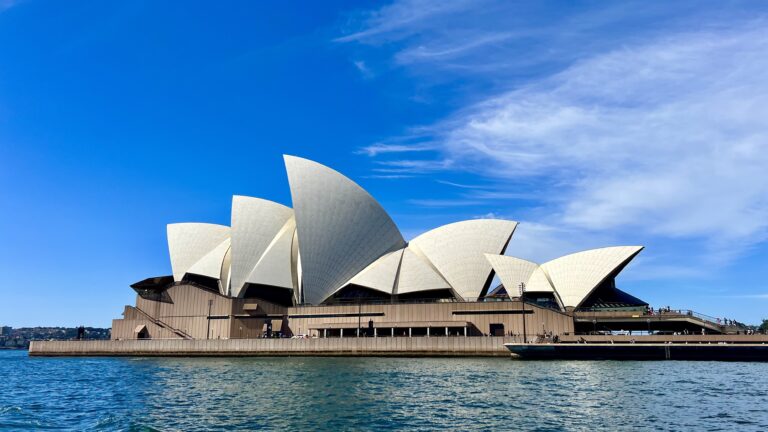Ultimate 3 Day Lisbon Itinerary: Discover Portugal’s Stunning Capital

Lisbon is an absolutely captivating city that we completely fell in love with on our visit for Eve’s birthday. With its picturesque cobbled streets, vibrant neighbourhoods and breathtaking views, Lisbon is a place where every moment feels like a step into a storybook. Whether you’re wandering through the whimsical alleys of Alfama, savouring the renowned pasteis de nata, or marvelling at the grandeur of Belem, Lisbon offers a magical experience that’s simply unforgettable. As our guide on our walking tour said on the first day, Lisbon is different to other capital cities as it does not have those ‘iconic’ landmarks (such as the Colosseum in Rome or Sagrada Familia in Barcelona) but what it does have is a beautiful and inviting culture which honestly makes you never want to leave. In this enchanting 3 day itinerary, we’ll guide you through the very best of this fascinating city, ensuring your visit is as spellbinding as Lisbon itself. Get ready to embark on a journey that promises to be nothing short of extraordinary!
Where to Stay
First things first, where should you stay to make the most of your Lisbon experience? There are so many different areas and options! Here are our top recommendations for neighbourhoods that will put you at the centre of Lisbon’s action.
Baixa
This is Lisbon’s downtown area, known for its grand squares and historic architecture. Baixa is a fantastic location for shopping and dining and the famous Rue Augusta (a key promenade through the heart of Lisbon) runs through this area. It is the most centrally located area to stay, so you will be close to everything you need and have easy access to major attractions like the Praça do Comércio and the Rossio Square.
Chiado
Adjacent to Baixa, Chiado is a stylish and historic district known for its cafes and theatres. Chiado offers a range of accommodation, from luxurious hotels to boutique guesthouses. Historically, it has been a hub for intellectuals, artists and writers. Staying here puts you in the heart of Lisbon, close to key attractions, vibrant nightlife and excellent transport links.
Bairro Alto
Famous for its lively atmosphere and bohemian charm, Bairro Alto is perfect if you want to be close to bars, restaurants, and live music venues. It is considered one of Lisbon’s most dynamic and eclectic neighbourhoods. It’s also centrally located, close to Chiado and Baixa making it easy to explore other parts of the city either on foot or by public transport.
Alfama
Alfama is the oldest district in Lisbon, characterised by its narrow, labyrinthine streets and traditional architecture. It has a very traditional charm and is known for its Fado music and historic sites like the São Jorge Castle. While the narrow streets can be slightly more challenging for navigation and transportation, the unique ambiance and proximity to key attractions make it a rewarding choice for those seeking a genuine connection with Lisbon’s heritage.
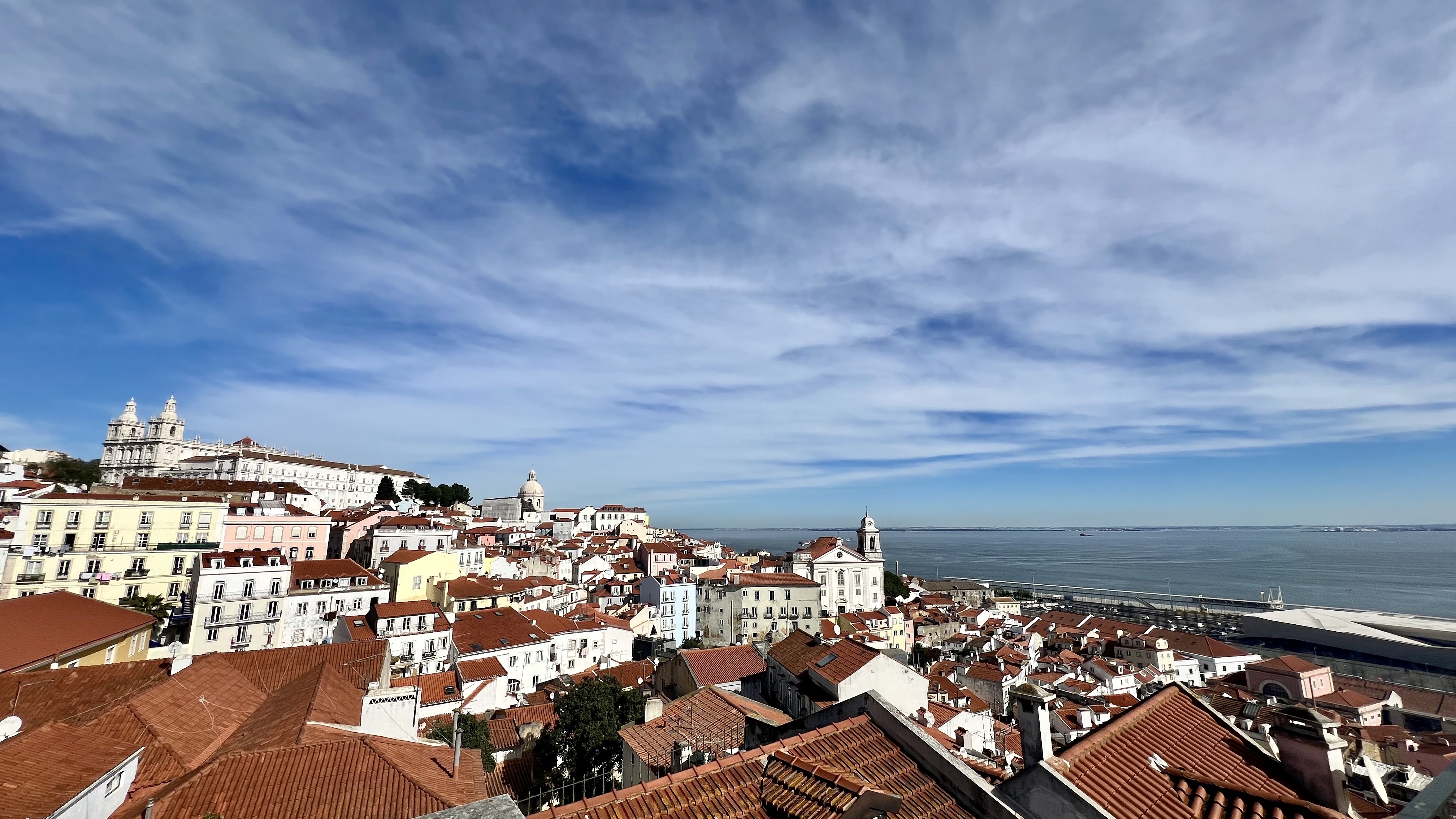
Getting Around Lisbon
We found Lisbon to be a remarkably easy city to navigate. Most of our exploration was on foot, as, despite its hills, Lisbon is quite walkable and enjoyable. For destinations a bit further afield, the city’s efficient combination of buses, metro, and trams proved perfect for getting around seamlessly.
Metro
Lisbon’s metro system is modern and efficient, covering major parts of the city. It’s a convenient way to travel quickly across town. There are four main lines, each marked by a colour: Blue (Linha Azul), Yellow (Linha Amarela), Green (Linha Verde), and Red (Linha Vermelha). They intersect at key points, making it easy to transfer between lines.
Trams
Lisbon’s trams provide a fun and scenic way to see the city. The trams here are particularly famous and are a very popular tourist attraction. Tickets can be bought on board or at metro stations.
Buses
Buses cover areas not served by the metro and are useful for reaching destinations like Belem and other outlying areas. There are numerous bus routes which run pretty frequently.
Funiculars and Elevators
Lisbon’s hilly terrain has led to the development of several funiculars and elevators, helping residents and visitors avoid the steep streets if desired. This offers a convenient and scenic way to navigate the city without tiring your legs.
Taxis
Taxis are widely available throughout Lisbon. They can be hailed on the street or at taxi stands. Services like Uber and Bolt operate in Lisbon and are can be used for convenient travel within the city.

Top Tips for Your Trip to Lisbon
- Many Lisbon attractions offer free entry on the first Sunday of the month (MAAT Art Gallery, National Tile Museum, National Pantheon are a few). If you are planning a trip around this day, make sure to organise your itinerary accordingly!
- While many people in Lisbon speak English, learning a few basic Portuguese phrases can enhance your experience and show respect for the local culture. Simple greetings and polite phrases go a long way. Remember that some Portuguese words are pronounced slightly differently depending on whether you are male or female, such as the word for ‘thank you,’ which is either ‘Obrigado’ (male) or ‘Obrigada’ (female).This does not change for who you are speaking to – if you are a woman, you will always say Obrigada, and men will always say Obrigado.
- If you are planning to use public transport frequently, consider purchasing a Lisboa Card. This offers unlimited travel and free entry to 51 of Lisbon’s top museums and attractions!
3 Day Lisbon Itinerary
Day 1
Morning
The first spot on our list is the Funicular da Bica. When you head to the top of this funicular route you will find the iconic yellow tram sitting there. It is usually very quiet first thing in the morning, so you can snap your photos free of people.
Next up, grab a Pastel de Nata (a traditional Portuguese custard tart) from the infamous Manteigaria. We recommend covering it in cinnamon before you eat (the local way). Manteigaria is located next to Praca de Luis de Camoes, a quaint tiled square in the centre of the Chiado area of Lisbon. Here, order a coffee from the green kiosk and sit on a bench to watch passers by in the busy square. If time allows, we’d also recommend popping back to this square during an evening and ordering some port to sip on whilst you listen to the live music performers playing here. For a unique taste, consider trying a local white or rosé port.
This square is the meeting point of many of the morning walking tours that run in Lisbon, which is the next item on this itinerary. We can highly recommend the ‘Tours Of My Life’ walking tour which is ‘free’ (pay what you feel the tour was worth to you in tips at the end). We absolutely loved this tour; it was incredibly informative and provided a fantastic way to explore various parts of Lisbon while delving into the city’s rich history. The tour includes visits to some breathtaking viewpoints, and you even get to enjoy a Pastel de Nata (for free) from Nata Lisbon midway through, adding a delicious touch to the experience.


Afternoon
For the afternoon start by visiting Praca do Comercio, head to Martinho da Arcada for a traditional seafood lunch (make sure to try the Bacalhau cod cake – a staple in Lisbon). Then wander down Rue Augusta to the Praca do Rossio. From here you can try the famous Ginjinha (a Portuguese liqueur made by infusing morello cherries in alcohol). The most famous shop for these is called A Ginjinha, which was the was the first bar to sell ginjinha in Lisbon, and is a designated Loja Com História (historic shop). A Ginjinha has been pouring its signature sour cherry liqueur, Espinheira Ginja, since 1840. Across the square their rival, literally called Ginja Sem Rival, opened in 1890 and is still run in the same location. They are a well known competitor to A Ginjinha, so go ahead and try both and decide which you prefer.
If you take the walking tour, you may have already been taken to the Elevador de Santa Justa. Opened in 1902 (and originally powered by steam), it was built by the Portuguese born French architect, Raoul de Mesnier du Ponsard, apprentice to Gustave Eiffel (yes that one!). Since it was opened to the public, it has become one of the most popular viewpoints in Lisbon. It costs €5.30 per person to ride up. However, you can also enter the viewing platform by heading to the Carmo Convent and walking to the right hand side of the convent, past the cafe and onto the platform – without having to pay a penny!
This will set you up perfectly to visit the Carmo Convent next, otherwise known as The Convent of Our Lady of Mount Carmel, if you have the time to say that! This former Catholic church was drastically damaged during the 1755 Lisbon earthquake, but is still a wonderful example of ancient medieval architecture. The museum is very informative and there some very sweet stray cats wandering around inside.
Evening
The Miradouro de Santa Catarina is the perfect sunset spot in Lisbon. With views over the city and a resident busker performing every evening, it is the ideal chilled evening vibe. There is a kiosk serving takeaway drinks, so grab one, take a seat, listen to the music and watch the sky turn to every beautiful shade of red, orange and pink.
For dinner, we suggest heading down to the Time Out Market. Originally a traditional market dating back to the 19th century, it was revitalised in 2014 into a modern food court that brings together some of the city’s best chefs, restaurateurs, and culinary talents under one roof. The market offers an eclectic mix of street food, gourmet dishes, and artisanal products. There’s so much on offer to choose from!
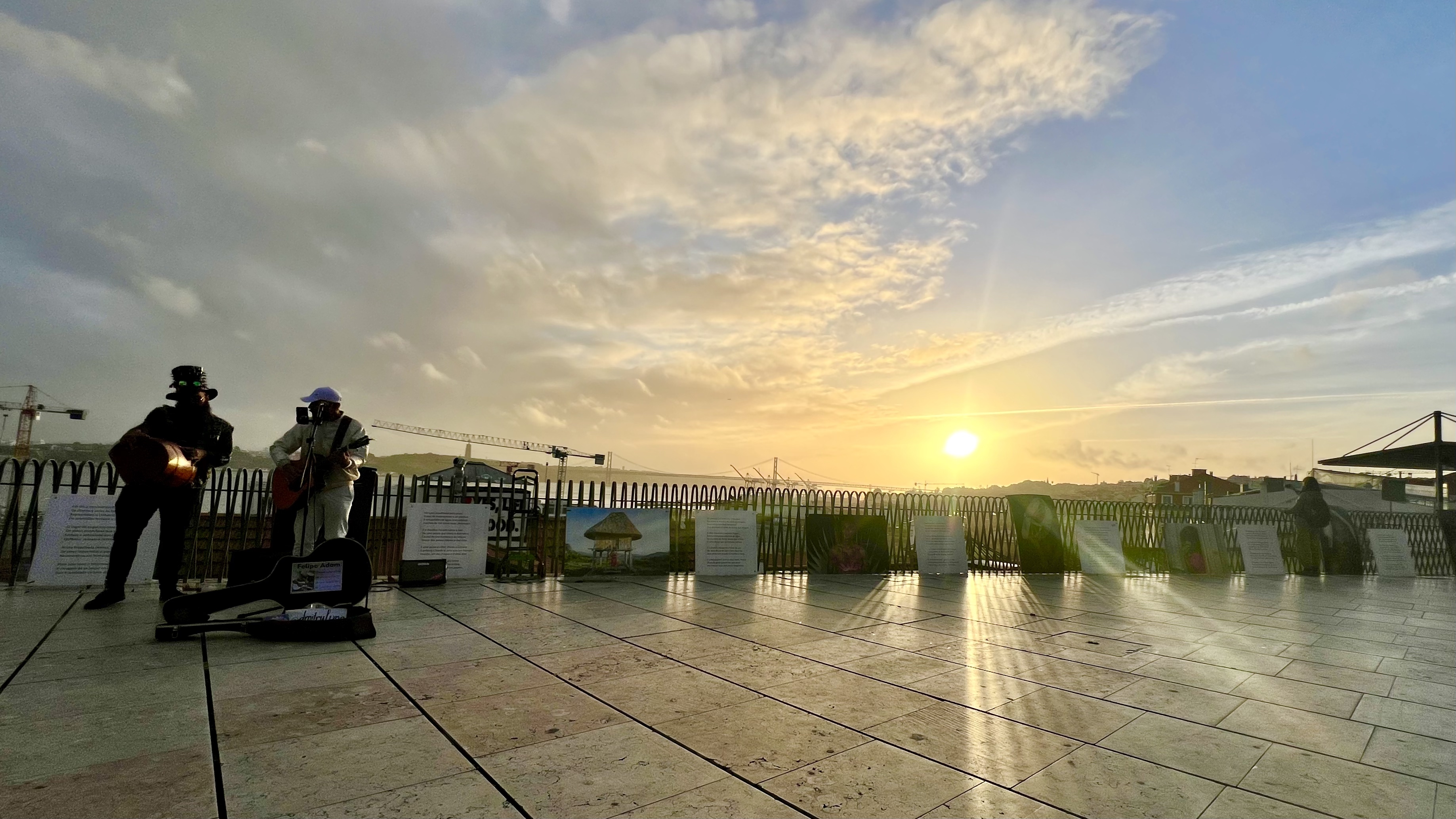
Day 2
Morning
For a morning spent in Belem, we recommend heading to Cais Sodre train station and taking the 10 minute train journey down the coast. On your way to the station snap a shot Pink Street before the tourists arrive. This street is a hub for partying, and for centuries was known for its brothels, gambling and drinking – mainly for the sailors that would dock close by. It is still a popular area for nightlife, and has a prominent pink painted road.
Once in Belem head directly to Pasteis de Belem, the original creator of the Pastel de Nata. Here you can try their original egg tart recipe. The Belem Monastery (Mosteiro dos Jerónimos) is located just a minute away from the Pasteis de Belem. This impressive monastery is renowned for its stunning architecture, rich history, and cultural importance.
The Belem Tower, oficially known as the Tower of Saint Vincent, is a 16th-century coastal fortification. It served as a departure point for Portuguese explorers and a symbolic gateway to Lisbon. It is a beautiful building set on the Tagus river not far from the monastery. After paying a visit to this monument, follow the river down to the MAAT Art Gallery. Even if you don’t head in to the gallery, the building itself is worth visiting. Admire the ceramic tiles and the rooftop terrace, with a beautiful view over the river and of the impressive 25 de Abril Bridge.
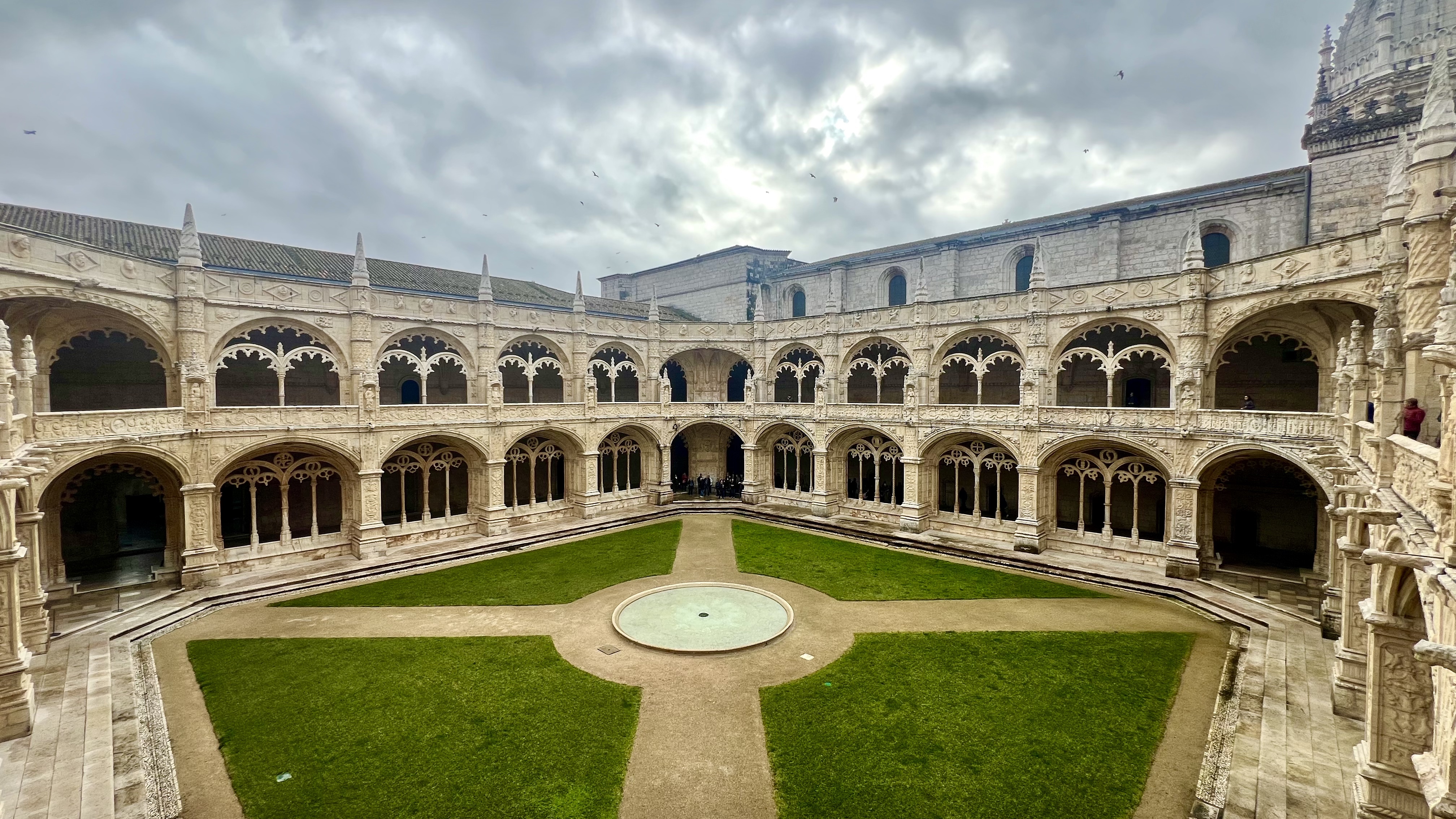
Afternoon
Next, hop on the bus to LX Factory. LX Factory was once an industrial site that housed textile factories and other industrial facilities. In the early 2000s, the area underwent a transformation into a creative space. Today, it’s a must visit destination for anyone seeking a blend of art, culture, and gastronomy. As you stroll through this labyrinthine of streets, you’ll encounter an eclectic mix of quirky shops, where local artisans showcase unique crafts, vintage finds, and fashion. The area is also home to a variety of cool bars and trendy restaurants, offering everything from gourmet meals to casual bites and cocktails.
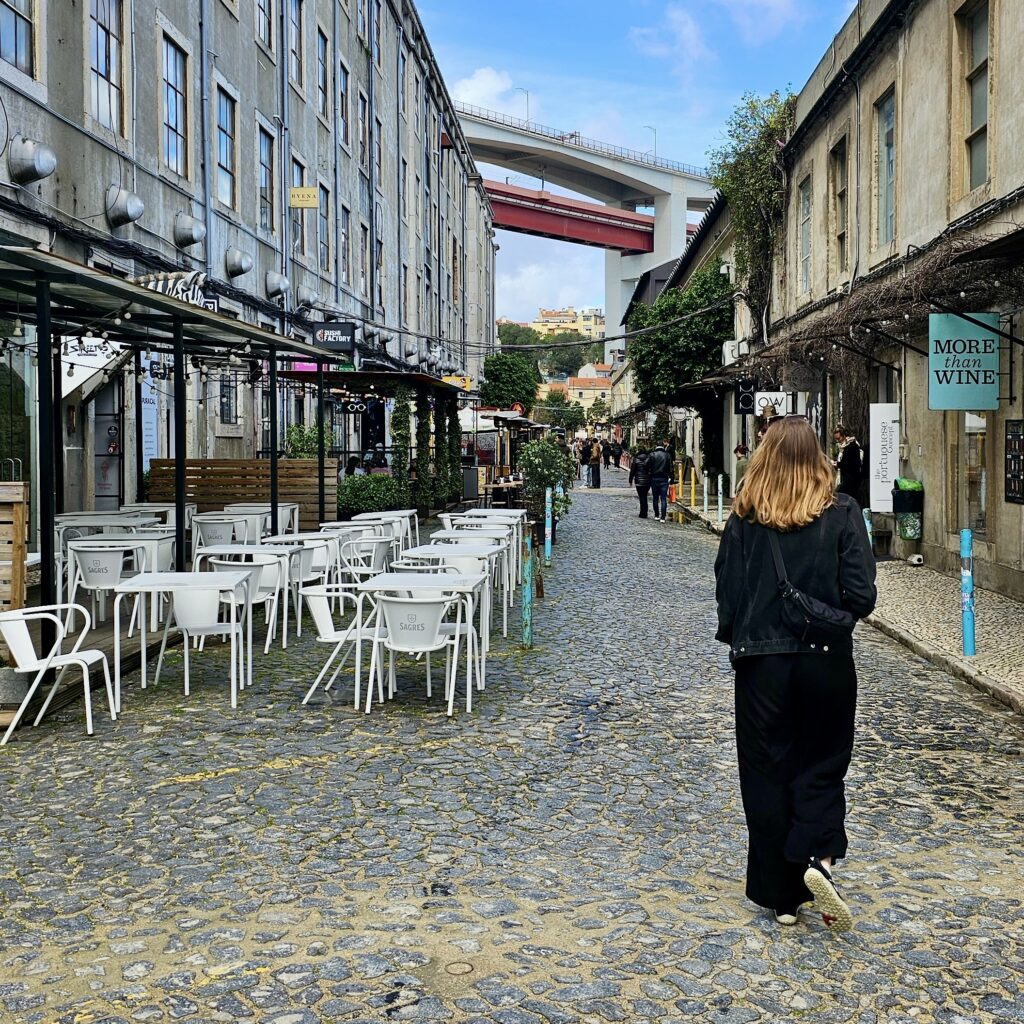

Evening
In the evening, head back into the city and up to Park Bar for sunset. Park Bar’s setting is as unconventional as it is charming. Located on the rooftop of a modern car park building, the bar boasts panoramic views of Lisbon’s skyline and is perfect place to relax after a busy day and enjoy some drinks and nibbles looking out at the sunset.
Day 3
Morning
For your morning coffee, head to Fabrica Coffee Roasters, a speciality cafe located very close to the Praca de Luis de Camoes. After this, head to the Chiado tram stop to take a tram to Alfama. You are able to take either the 12 or 28 tram to this area. Tram 28 is more frequent and takes a longer route, making it a popular choice for tourists (which also means it is often very crowded). Tram 12 is shorter and less busy, which can be an advantage if you prefer a quieter ride.
Once in Alfama, wander around the narrow streets and get a feel for Lisbon’s heritage. Alfama is the oldest district in Lisbon and it feels a world away from the hustle and bustle of the other areas of the city. Walk along the Mural de Azulejos admiring the colourful tiled walls, and ending up at the National Pantheon.
If visiting on a Tuesday or Saturday, make sure to spend some time looking around the Mercado de Santa Clara. This market hosts a diverse array of many food stands showcasing cuisines from around the world and an eclectic mix of bric a brac stalls selling all sorts of antiques and trinkets. It’s open between 9am-6pm on both these days.


Afternoon
Now it’s time for the walk up to Castelo de São Jorge. This is one of Lisbon’s most iconic landmarks, offering visitors a fascinating glimpse into the city’s rich history along with breathtaking panoramic views. It is perched on top of a hill in the Alfama district and will take you 20 to 30 minutes to walk from the base of the hill to the castle. However if you don’t fancy the walk, there is a funicular tram available.
Evening
In the evening we’d recommend the Miradouro de Santa Luiza. This viewpoint offers a stunning panorama of Lisbon’s red-tiled rooftops, the castle, and the river. It’s an excellent spot for capturing photos of the cityscape and enjoying Lisbon’s scenic beauty. A fabulous sunset spot.
Then it’s time for an authentic Portuguese Fado Show! These traditional performances make for an unforgettable evening. Relax and enjoy some delicious petisco (Portugese tapas), whilst connecting with the soulful melodies of some Portugese culture. We recommend these venues, and strongly advise booking in advance.
Clube de Fado
Clube de Fado is a renowned venue in Alfama, celebrated for its intimate atmosphere and high quality performances. It’s well regarded for featuring some of the best Fado artists in Lisbon.
A Tasca do Chico
Located in Bairro Alto and known for its casual and authentic vibe, A Tasca do Chico is a beloved spot for Fado enthusiasts. The venue offers a more laid back atmosphere, with live Fado performances often featuring local artists.
If You Have More Time
Sintra
Located just a 30 minute train ride away from Lisbon and incredibly popular place to visit is Sintra. A picturesque town known for its fairytale palaces and lush landscapes. Explore the colourful Pena Palace, the imposing Moorish Castle, and the beautiful Montserrate Palace. Sintra’s natural beauty and historic sites make it a wonderful trip from Lisbon. For the perfect day trip to Sintra read our guide here.
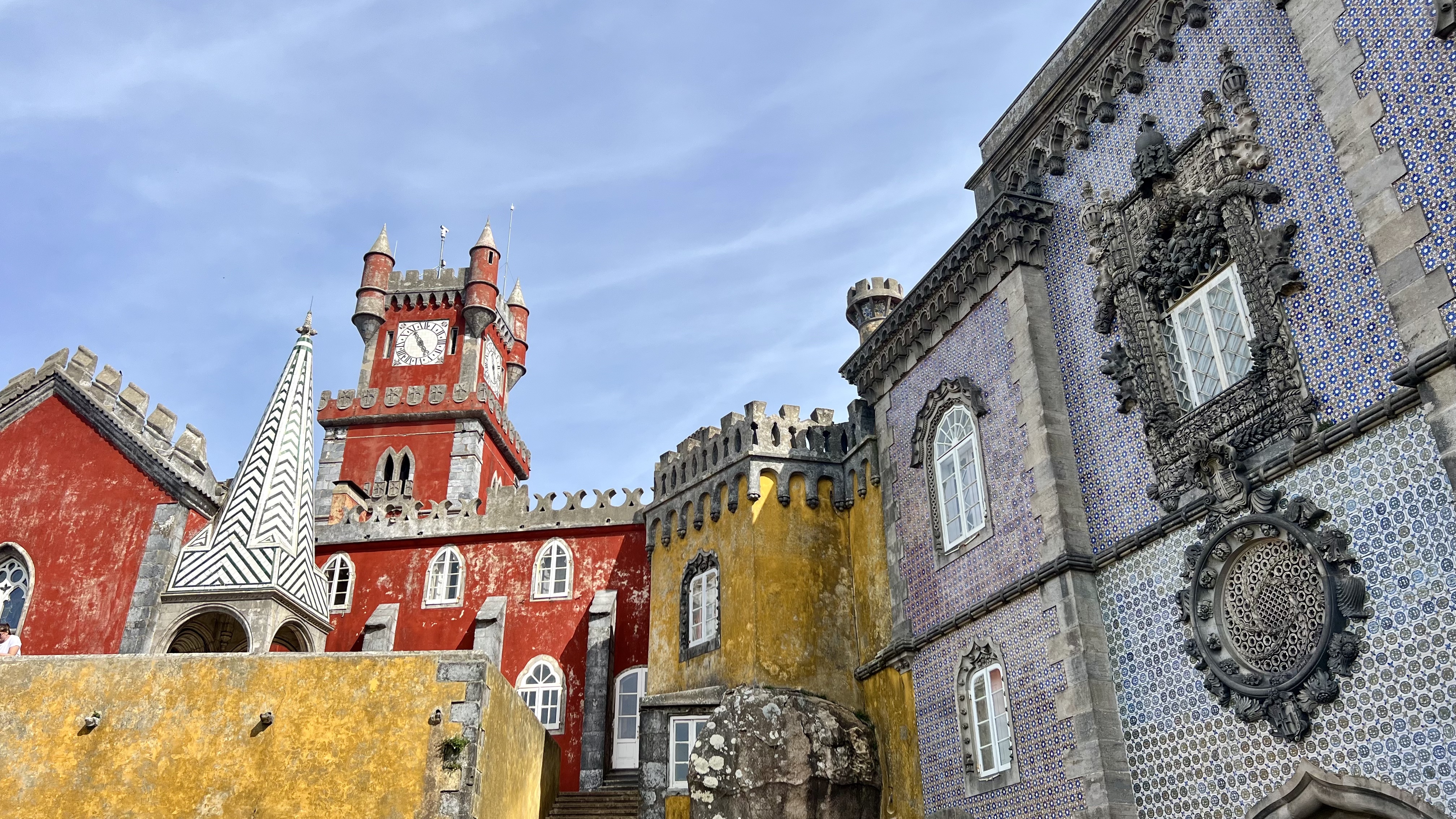
Caiscais
The train ride from Lisbon’s Cais do Sodre station to Cascais takes about 40 minutes, providing a scenic preview of the region’s natural beauty, offering glimpses of the Atlantic ocean. Popular with surfers and sunbathers alike, discover the stunning beaches of Praia da Rainha and Praia do Guincho. Wander through the cobbled streets of Cascais’ old town, where you’ll find beautifully preserved buildings, charming cafes and quaint shops, including a lovely little bookbinder that we enjoyed visiting called Arte no Livro.
Final Thoughts for Your 3 Days in Lisbon
We hope this itinerary has helped you uncover the essence of Lisbon and provided a glimpse into the city’s unique charm. Lisbon’s magic lingers long after you’ve left, and the city has a way of capturing your heart and making you yearn for a return. Thanks for joining us on this journey through one of Europe’s most enchanting cities and we hope you have a wonderful adventure!





